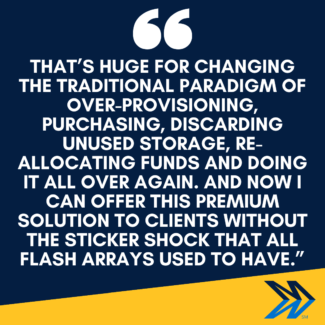February 27, 2017
In late February 2017, the Mindsight blogging team sat down with Chuck Hernandez, Systems Engineer with Pure Storage, to talk about the effectiveness of flash storage solutions. Flash storage is finally cost effective and the success of flash-focused storage developers like Pure Storage is evidence of that. Hernandez shared with us a client story in which flash storage proved to be the right solution for a stalled manufacturing company.
Mindsight Blogging Team (MBT): To start, Chuck, please introduce yourself and explain your role at Pure Storage?
Chuck Hernandez (CH): Sure, I’m Chuck Hernandez, Systems Engineer with Pure Storage and my role and function is probably 70% presales and 30% after or post sales activities. The presales activities of course involve gathering customer requirements, understanding their environment, and then working with the account executive or sales person to craft the solution. So that’s what I do.
MBT: Great. Could you take a few moments to describe the client and the problems they were experiencing?
CH: The client is a manufacturer who makes office supplies. They make foldable cardboard file boxes and other file storage systems. That’s the core business, but they now also make air purifiers, shredders, and other related products. They’re located here in Chicagoland.
There were really a handful of things they needed to address. At the top of the list was that they had older NetApp filers. They were looking for a new solution that would give them better performance, a better resiliency, better reliability, and—ultimately what I could call—a more agile and adaptable environment.
They really wanted to move forward and move away from the traditional, very monolithic storage platform of the past and into something modern. This new platform would not only give them speed, but add value in a number of ways including agility and simplicity. The new platform would make it easier for them to meet their internal and external customer needs.
In particular, the client had a website with an ecommerce store, and they really needed to find a way to improve the speed and performance of this site. The needed to get something faster and more current and more up to date as well as more agile to keep their business flowing smoothly.
MBT: What was your recommended Pure Storage solution to their issue?
CH: We ultimately recommended to them a pair of flash array M20 systems—one for their productions facility at their corporate office and one for a [disaster recovery] facility at a colocation. So, they would then have two flash arrays M20s, and they replicate data between each other.
MBT: How did this solution address their specific problem?
CH: Well, their primary databases are SQL and Oracle, and the Oracle infrastructure that they have are older HPUX large, mid-sized systems. They’re gradually becoming more and more expensive to maintain and operate and were headed towards their End of Life. By pursuing a Pure Storage solution, the client was able to modernize their applications and move into a more open environment. This included Linux and Intel-based processors for their Oracle, and of course, windows-based virtual machines for their SQL environment.
MBT: How did this solution play out?
CH: The first step was we actually ran a Proof of Concept (PoC). During the PoC, they had a subset of very specific applications that they wanted to test, and very specifically, they wanted to ensure that they could create and recover their databases without issue and recover them cleanly. In other words, when they recover a database, they need the database to come online and be accessible in a relatively small time frame. I’m talking 20 minutes or less.
So part of the testing was to create databases, migrate them from their existing environment, test the databases on the Pure array, have the two Pure arrays running, and have the databases replicating. Then they would break the replications, break off one of the database instances, and then mount it to the test systems. Once mounted, we could then start using it as if they actually had a failover event or some event in which they wanted to bring a database up at the DR site.
They ran those tests, and it worked for their Microsoft SQL as well Oracle environment quite effectively. We did quite a bit of testing. We also did scripting. We used powershell scripting to do some of the cleanup work that’s needed when you do these type of failovers. With all of that working together, they were able to do an end-to-end test and have their application up and running on both sides of the environment. We simulated a failure and had the remaining side take over, come up, and run for both their SQL and Oracle environments. That was the primary test. Of course, inside that are virtual machines as well as physical hosts that had to failover and resume operations during these tests.
MBT: After the test was completed and the solution was actually implemented, what kind of results did the client see?
CH: Well the long and short of it is everything runs a lot faster. So, they’re very happy with the throughput. They’re able to maintain performance without any noticeable degradation during all of their operations. That includes their standard operations, testing and backup, and creating new environments. All these things happen so quickly and so efficiently because of the technology of Pure Storage.
Everything in the environment is served by creating metadata copies that are very fast and efficient. And by doing that, they’re able to create all these copies, run these tests, and do it in a way that isn’t impacting their production. So that was the big plus.
All these things that used to impact production, all these things for which they had to schedule maintenance windows and schedule off-hour service outages or downtime to do, they no longer have to do. Everything stays up 100% of the time, and they’re able to run seamlessly 24/7. That’s a big business plus, especially because they have customers worldwide, so they do have the need to be online 24/7.
MBT: Taking a step back to look at manufacturing in general, how does Pure Storage lend itself to goals in the manufacturing industry?
CH: I think the biggest thing is that firstly, Pure Storage is an extremely simple platform to manage and operate. Because of that simplicity, it does enables our customers to focus on their core business. For example, for this particular customer, they do a lot [of business] through ecommerce. They need their ecommerce site to be up, running, and performing all the time—24/7. Other manufacturers may have integrated manufacturing and they need systems that are always up and running online.
You can imagine other industries like financial services, where speed and throughput and availability are critical. All of these elements are things that we do very well. We give the best possible combination of simplicity, speed, reliability, and efficiency.
MBT: Are there any aspects of Pure Storage—and it might just be the simplicity and data reduction you’re talking about—that were uniquely beneficial to this client that they couldn’t have gotten from an alternative flash solution?
CH: I do think that simplicity and superior data reduction is key. In terms of speed and performance, there are others who are in the ballpark of delivering similar experiences for their customers, but when you add the simplicity and the ease with which it can be managed, there’s just no one who comes close. We eclipse the competitors.
The other thing is resiliency. Believe it or not, a lot of competitors have problems delivering non-disruptive operations on a 24/7 basis, and our technology and architecture allows us to run arrays constantly. I would say that if you follow best practices with your Pure Storage array, and you work with your Pure Storage support team, you can run your arrays 24/7/365 days a year. Never having to take outages, never having to schedule downtimes—it’s just a matter of adhering to best practices.
MBT: Where do you see flash storage headed in the future?
CH: I think the big story for Pure is that we’ve been a block storage solutions company since our inception in 2009, and recently, we have launched a file services and object store product called Flash Blade. When you put the two side by side, we have an all flash portfolio that is going to change how a lot of people do business.
We’re going to be able to not only host and support their primary mission-critical block storage workloads, but we’re also going to be able to handle their file-services workloads as well and do it in a very analogous way. So, we’ve broadened our portfolio, and it’s just going to be a better and better story for customers with a more complete solution set.
I think the Flash Blade will go a long way to help clients get to an all flash data center. I truly believe we’re on the very starting edge of seeing data centers that eliminate spinning disk 100%. They’re going to migrate to all flash. They’re going to have all their workloads on flash, and spinning disk is really going to fall away and become an obsolete, archaic technology. That’s where we are in the industry, and I think that that’s going to be a major shift.
You know, something that a lot of people don’t realize is flash failure rates are .1% or less per year as compared to 4-6% for spinning disk. So when you put that in context, it’s 40-50 times more reliable. Not only is it faster. Not only is it more efficient, but it’s more reliable at a very significant level. The last thing I’d say, is that I see us on the verge of a new era where data centers truly are going to be 100% disk-less and that’s going to be big. That’s going to be big.
On the Verge
Hernandez brought up a salient point at the end of the interview that is not as widely discussed in technology circles. Flash is significantly more reliable than disk storage, and as companies become more and more integrated with technology, a company’s data is going to become (if it already isn’t) the company’s most precious asset. The reasons to put off an upgrade to flash storage at the next refresh cycle are becoming fewer by the day.
Through training and our own expertise with Pure Storage solutions, Mindsight has earned the Pure Storage Silver Partner certification. Contact Mindsight today to discuss with our consultants how Pure and flash storage can prepare your environment for a new generation of data centers.
Like what you read?
About Mindsight
Mindsight, a Chicago IT services provider, is an extension of your team. Our culture is built on transparency and trust, and our team is made up of extraordinary people – the kinds of people you would hire. We have one of the largest expert-level engineering teams delivering the full spectrum of IT services and solutions, from cloud to infrastructure, collaboration to contact center. Our highly-certified engineers and process-oriented excellence have certainly been key to our success. But what really sets us apart is our straightforward and honest approach to every conversation, whether it is for an emerging business or global enterprise. Our customers rely on our thought leadership, responsiveness, and dedication to solving their toughest technology challenges.
Contact us at GoMindsight.com.







 “Pure is pushing the envelope technologically,” White says. “When it’s time for an upgrade, our clients with Pure are not replacing any drives, just the controller units. It eliminates a ton of downtime, but even more importantly, our clients can take advantage of all the storage they’ve already purchased with their new controller. That’s huge for changing the traditional paradigm of over-provisioning, purchasing, discarding unused storage, re-allocating funds and doing it all over again. And now I can offer this premium solution to clients without the sticker shock that all flash arrays used to have.”
“Pure is pushing the envelope technologically,” White says. “When it’s time for an upgrade, our clients with Pure are not replacing any drives, just the controller units. It eliminates a ton of downtime, but even more importantly, our clients can take advantage of all the storage they’ve already purchased with their new controller. That’s huge for changing the traditional paradigm of over-provisioning, purchasing, discarding unused storage, re-allocating funds and doing it all over again. And now I can offer this premium solution to clients without the sticker shock that all flash arrays used to have.”